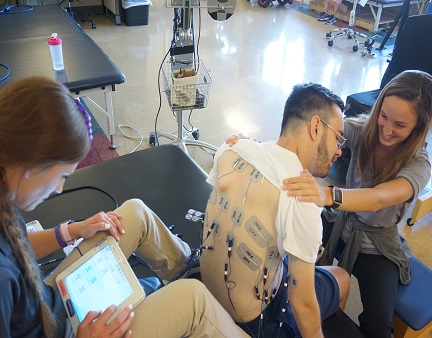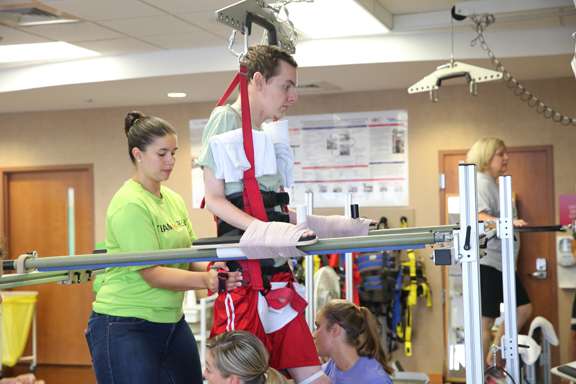 NeuroMuscular Electrical Stimulation (NMES) is a form of activity-based rehabilitation that uses pulses of electrical current to evoke muscle contractions and patterned muscle activity to complete a specific task. Electrical stimulation enables muscles to work and perform activities even though the muscles may be weak or paralyzed through neurological disease or injury. NeuroMuscular Electrical Stimulation (NMES) is a form of activity-based rehabilitation that uses pulses of electrical current to evoke muscle contractions and patterned muscle activity to complete a specific task. Electrical stimulation enables muscles to work and perform activities even though the muscles may be weak or paralyzed through neurological disease or injury.
 Lower extremity and arm bike NMES provides cycling movements during neuromuscular electrical stimulation. A new activity-based intervention with the new RT Stimulators and Sage stimulates Upper Extremity movements focusing on specific tasks and optimizing muscle strength with the guidance of a skilled activity-based technician/trainer. Lower extremity and arm bike NMES provides cycling movements during neuromuscular electrical stimulation. A new activity-based intervention with the new RT Stimulators and Sage stimulates Upper Extremity movements focusing on specific tasks and optimizing muscle strength with the guidance of a skilled activity-based technician/trainer.
If you volunteer to participate in this study, we will ask you to participate in one of three training programs (stand, FES or stand+FES training described below). The training program we will ask you to participate in will be chosen by chance (i.e. like flipping a coin). You will be asked several questions about physical and related activities (such as muscle movements you have in your legs and how much exercise you do in a week) at the beginning and end of your participation. You have the right to refuse to answer any questions that you may not wish to answer and to refuse any test. Whether you are in the stand, the FES, or stand+FES group you will participate in separate experiments over a two to four week period. We will videotape how you will stand and step during the training sessions and experiments.
TESTING BEFORE, DURING AND AFTER TRAINING: As mentioned above, in each of the training programs, there will be a set of experiments conducted before, during and after the 60 training sessions.
- Muscle Activity Experiments: In these experiments we will test the activity of your muscles while you are either stepping or standing with on a treadmill or overground. Sensors pasted to the skin with tape will record the electrical activity of your muscles during resting conditions, standing, or while you move during the stepping. Other sensors pasted to the skin record the position of your legs. We will need to shave your legs in order to have a close contact between your skin and these sensors. Reflective markers will be attached to your skin on your pelvis, legs, hips, arms and trunk. Flat insoles will be placed inside shoes that we provide for you to walk in. These insoles will record the amount of weight on your legs. These experiments will last from 3 to 5 hours. You will have the opportunity to rest at any time during the trial.
- Functional Electrical Stimulation (FES) Testing: You will be lying down, standing or stepping and will have self-adhesive patches (electrodes) placed on your skin at your calf, and the front and back of your thigh. These electrodes, connected to a battery-operated unit, will send a small current to my muscles and cause them to tighten. The electrical stimulation unit has been tested and is safe. You will be instructed in safe and effective self-administration of the electrical stimulation, as appropriate. To carry out this experiment, you may be stand or step on a treadmill while wearing a harness that is attached to an overhead suspension device that will support the weight of your body.
- Bone Mineral Density Test (DEXA): You will be asked to have a DEXA scan to measure the thickness of your bones. This scan should take less than 1 hour. You will have your entire body scanned by a large machine while lying on your back. You will have to lie still during the test. This scan will take place at Jewish Hospital (225 Abraham Flexner Way, Suite 502). You may be asked to repeat these tests one to five times within the next year.
- Blood and Urine Tests: You will have blood (about 2 tablespoons) and urine samples taken to determine the level in your body of certain natural chemicals that give information about bone formation and bone loss. All specimens obtained during this study will be stored in the Basic Science Laboratory at Center of Excellence on the Medical Consequences of Spinal Cord Injury located at the James J. Peters Veterans Affairs Medical Center, Bronx, NY. A subject identifier (name and social security number) will be placed on the label along with the date and information regarding the study. Samples will be stored for future analysis specifically related to this study. Your samples will be stored until all data related to this study has been analyzed and at the end of this period your specimen will be destroyed.
- Magnetic Resonance Imaging (MRI): You will be given a scheduled time to have an image taken of your leg using magnetic resonance imaging (MRI) at Jewish Hospital. During this time you will lay quietly on a table while the images are taken of your leg. The total testing time for this portion of the testing will take approximately 1 hour.
- Cardiac Output and Stroke Volume: You will have your cardiac output determined using a non-invasive ultrasound technique using a Doppler probe. Using this measurement along with common readings such as heart rate and blood pressure, your stroke volume can be calculated.
- Other Tests: Other baseline tests will include questionnaires related to quality of life, functional measures to determine functional independence such as the seated/standing reaching test.
Since the procedures required for this study are not for diagnostic purposes any results will be reported to you from your study doctor, not from the institution where the procedure is being performed.
TYPES OF TRAINING: After you complete the initial testing above, you will begin one of three types of training. You will do the tests again once during your training sessions and again when you have completed all of your 60 training sessions.
- STAND TRAINING: Each stand training session will last about 1 hour and will occur 3-5 times weekly. To carry out these sessions, you will be helped to stand on a treadmill while wearing a harness that is attached to an overhead suspension device that will support the weight of your body. There will be one person behind you and at your hips to help keep you stable. There will also be one person at each of your legs to help you stand. If you feel tired or need a break during the session you can take a break at any time. In the 15 weeks that you will do the 60 sessions, the goal will be to reach standing with no assistance from the overhead suspension device that will support the weight of your body. At the end of the stand training program, we will ask you to repeat the same experiments that you did in the beginning of the study.
- FUNCTIONAL ELECTRICAL STIMULATION (FES) TRAINING: You will be lying down and will have self-adhesive patches (electrodes) placed on your skin at your calf, and the front and back of your thigh. These electrodes, connected to a battery-operated unit, will send a small current to my muscles and cause them to tighten. The electrical stimulation unit has been tested and is safe. You will receive stimulation for 60 minutes each day for 60 sessions (3-4 sessions/week). You will be instructed in safe and effective self-administration of the electrical stimulation, as appropriate.
- STAND TRAINING + FES TRAINING: If you are assigned to this training group, you will receive the stand and FES training described above for 60 minutes a day for 60 sessions (3-4 sessions/week).
BACK TO TOP
|
Adult NeuroRecovery Program
Neuromuscular Electrical Stimulation
Muscle Oxidation
Urogenital
Translational Research at KSCIRC
Translational Science Cores
Research Programs
Translational Support Cores
Clinical Trials
NACTN
ClinicalTrials.gov
|
 NeuroMuscular Electrical Stimulation (NMES) is a form of activity-based rehabilitation that uses pulses of electrical current to evoke muscle contractions and patterned muscle activity to complete a specific task. Electrical stimulation enables muscles to work and perform activities even though the muscles may be weak or paralyzed through neurological disease or injury.
NeuroMuscular Electrical Stimulation (NMES) is a form of activity-based rehabilitation that uses pulses of electrical current to evoke muscle contractions and patterned muscle activity to complete a specific task. Electrical stimulation enables muscles to work and perform activities even though the muscles may be weak or paralyzed through neurological disease or injury.
 Lower extremity and arm bike NMES provides cycling movements during neuromuscular electrical stimulation. A new activity-based intervention with the new RT Stimulators and Sage stimulates Upper Extremity movements focusing on specific tasks and optimizing muscle strength with the guidance of a skilled activity-based technician/trainer.
Lower extremity and arm bike NMES provides cycling movements during neuromuscular electrical stimulation. A new activity-based intervention with the new RT Stimulators and Sage stimulates Upper Extremity movements focusing on specific tasks and optimizing muscle strength with the guidance of a skilled activity-based technician/trainer.


